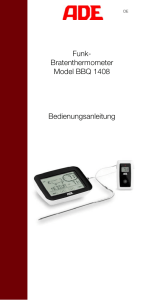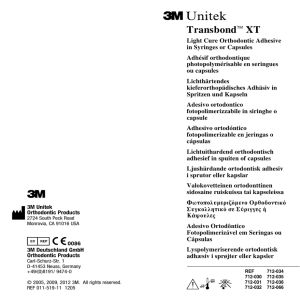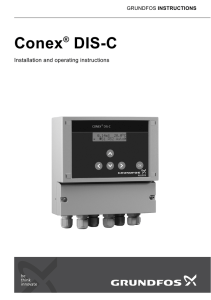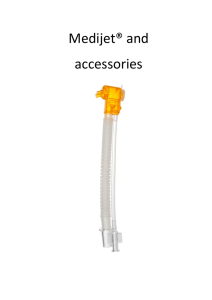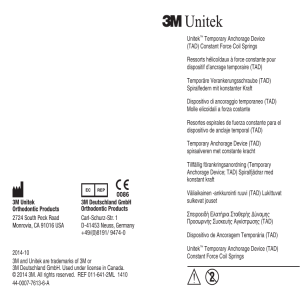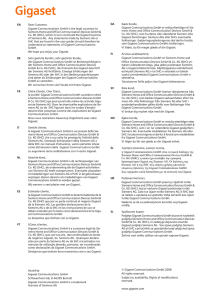Guida per l`utente – User`s guide Instructions pour l`utilisateur
Anuncio
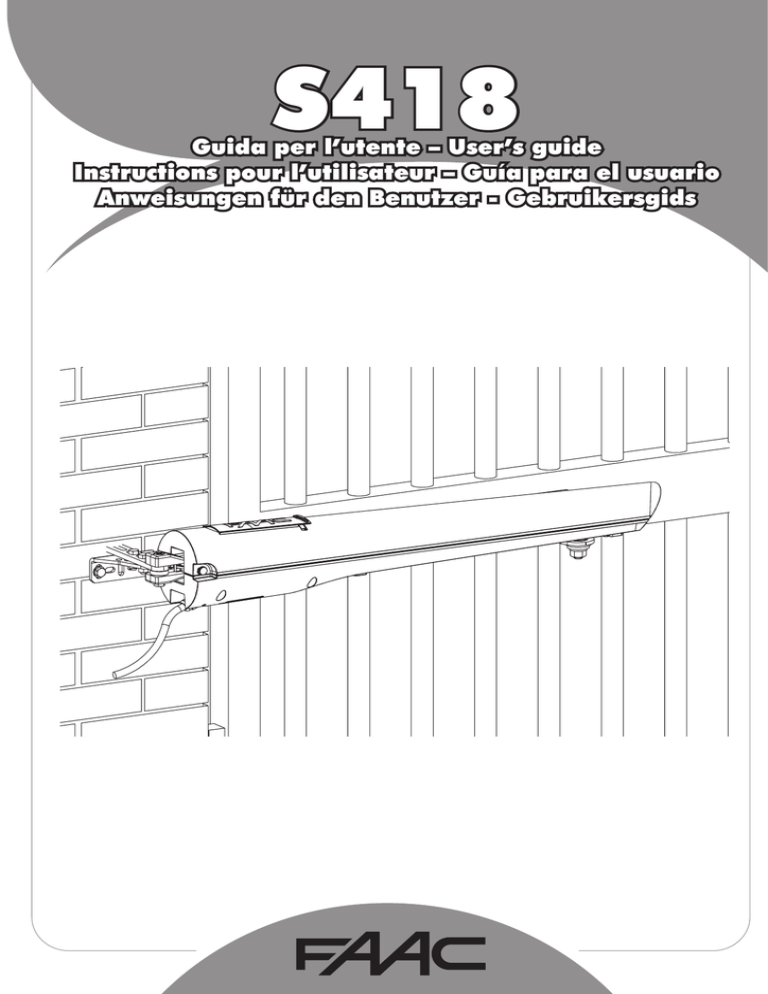
S418 Guida per l’utente – User’s guide Instructions pour l’utilisateur – Guía para el usuario Anweisungen für den Benutzer - Gebruikersgids ITALIANO Fig. 2 Fig. 1 FUNZIONAMENTO MANUALE Leggere attentamente le istruzioni prima di utilizzare il prodotto e conservarle per eventuali necessità future Nel caso si renda necessario movimentare manualmente l’automazione, per mancanza di alimentazione elettrica o disservizio dell’operatore, se deve agire sul dispositivo di sblocco come segue: 1. Togliere l’alimentazione all’impianto agendo sull’interruttore differenziale a monte dell’impianto stesso. 2. Far scorrere il cappuccio protettivo, figura 1 rif. 햲. 3. Inserire la chiave di sblocco in dotazione, figura 1 rif. 햳, e ruotarla in senso antiorario sino al suo arresto, figura 1 rif. 햴. La posizione di sblocco è segnalata da un lucchetto aperto. 4. Movimentare manualmente l’anta. NORME GENERALI DI SICUREZZA L’automazione S418, se correttamente installata ed utilizzata, garantisce un elevato grado di sicurezza. Alcune semplici norme di comportamento possono evitare inoltre inconvenienti accidentali: • Non sostare e non permettere a bambini, persone o cose di sostare nelle vicinanze dell’automazione, soprattutto durante il funzionamento. • Tenere fuori dalla portata dei bambini, radiocomandi o qualsiasi altro datore d’impulso che possa azionare involontariamente l’automazione. • Non permettere ai bambini di giocare con l’automazione. • Non contrastare volontariamente il movimento del cancello. • Evitare che rami o arbusti possano interferire col movimento del cancello. • Mantenere efficienti e ben visibili i sistemi di segnalazione luminosa. • Non tentare di azionare manualmente il cancello se non dopo averlo sbloccato. • In caso di mal funzionamenti, sbloccare il cancello per consentire l’accesso ed attendere l’intervento tecnico di personale qualificato. • Una volta predisposto il funzionamento manuale, prima di ripristinare il funzionamento normale, verificare che l’impianto non sia alimentato. • Non eseguire alcuna modifica sui componenti facenti parte il sistema d’automazione. • Astenersi da qualsiasi tentativo di riparazione o d’intervento diretto e rivolgersi solo a personale qualificato. • Far verificare almeno semestralmente l’efficienza dell’automazione, dei dispositivi di sicurezza e del collegamento di terra da personale qualificato. Per mantenere l’operatore in funzionamento manuale è assolutamente necessario lasciare il dispositivo di sblocco nella posizione attuale e l’impianto non alimentato. RIPRISTINO DEL FUNZIONAMENTO NORMALE Per ripristinare la condizione di funzionamento normale agire come di seguito: 1. Assicurarsi che l’impianto non sia alimentato. 2. Ruotare la chiave di sblocco in senso orario sino al suo arresto, figura 2 rif. 햲, ed estrarre la chiave, figura 2 rif. 햳. La posizione di blocco è segnalata da un lucchetto chiuso. 3. Chiudere il cappuccio protettivo, figura 2 rif. 햴. 4. Movimentare manualmente l’anta sino a quando non si avverte l’innesto del dispositivo, l’anta si blocca. 5. Alimentare l’impianto ed eseguire un paio di manovre per verificare il ripristino di tutte le funzioni dell’automazione. Durante il primo ciclo l’operatore potrebbe non eseguire correttamente i rallentamenti. Attendere comunque la fine del ciclo e ridare un comando d’apertura. MANUTENZIONE Al fine di assicurare nel tempo un corretto funzionamento ed un costante livello di sicurezza eseguire, con cadenza semestrale, un controllo generale dell’impianto prestando particolare attenzione ai dispositivi di sicurezza. Nel fascicolo “Guida per l’utente” è stato predisposto un modulo per la registrazione degli interventi. DESCRIZIONE L’automazione S418 per cancelli a battente è un operatore elettromeccanico che trasmette il movimento all’anta tramite un sistema a vite senza fine. Il sistema irreversibile garantisce il blocco meccanico dell’anta quanto il motore non è in funzione. Un comodo dispositivo di sblocco permette la movimentazione dell’anta in caso di disservizio o mancanza di alimentazione. Il funzionamento a bassa tensione permette di collegare delle batterie tampone, ovviando in questo modo a momentanee mancanze di tensione. Per il comportamento del cancello nelle diverse logiche di funzionamento, fare riferimento al Tecnico d’installazione. Nelle automazioni sono presenti dispositivi di sicurezza (fotocellule) che impediscono la richiusura del cancello quando un ostacolo si trova nella zona da loro protetta. La segnalazione luminosa indica il movimento in atto del cancello. RIPARAZIONI L’utente utilizzatore deve astenersi da qualsiasi tentativo di riparazione o d’intervento e deve rivolgersi solo ed esclusivamente a personale qualificato FAAC o centri d’assistenza FAAC. ACCESSORI Per gli accessori disponibili vedi catalogo FAAC. 2 MANUAL OPERATION Read the instructions carefully before using the product and keep them for any future needs If the automated system should need to be moved manually, owing to a power cut or operator malfunction, act as follows on the release device: 1. Switch off the power supply to the system using the differential switch located upstream the system. 2. Slide off the protective cap, figure 1 ref. 햲. 3. Insert the release key supplied, figure 1 ref. 햳, and turn it anticlockwise until it stops, figure 1 ref. 햴. The release position is indicated by an open padlock. 4. Move the leaf manually. GENERAL SAFETY NORMS The S418 automated system, if correctly installed and used, guarantees a high level of safety. Certain simple rules of behaviour can also avoid accidental hitches: • Do not stand or allow children or other people to stand, or items to be placed, close to the automated system, especially during operation. • Keep radio controls or other pulse generators out of the reach of children, to prevent the automated system from being activated inadvertently. • Do not allow children to play with the automated system. • Do not deliberately impede the movement of the gate. • Avoid branches or shrubs interfering with the movement of the gate. • Keep the signal lights clearly visible and operating efficiently. • Do not attempt to manually operate the gate unless the release device has been activated. • In case of malfunction, release the gate to permit access and wait for qualified technical personnel to arrive. • Once the system has been put in manual mode, before restoring normal operation check that the system is not powered. • Do not make any modifications to the components of the system. • The user must not attempt any kind of repair or direct maintenance whatsoever; these operations must only be carried out by qualified personnel. • Have the efficiency of the automated system checked at least every six months by qualified personnel, together with the safety devices and the earthing connection. To keep the operator in manual operation mode, the release device must categorically be left in its current position and the system not be powered. RESTORING NORMAL OPERATION To restore normal operation mode, proceed as follows: 1. Ensure that the system is not powered. 2. Turn the release key clockwise until it stops, figure 2 ref. 햲, and remove the key, figure 2 ref. 햳. The locking position is indicated by a closed padlock. 3. Close the protective cap, figure 2 ref. 햴. 4. Manually move the leaf until you note the engaging of the device; the leaf locks. 5. Power the system and perform a few operations to check that all functions of the automated system have been restored. During the first cycle, the operator might not slow down correctly. However, wait for the end of the cycle and then give the opening command once again. MAINTENANCE In order to ensure correct operation and constant safety over time, make a general check of the system every six months, paying special attention to the safety devices. In the booklet “User guide”, a form has been prepared for the recording of maintenance operations. DESCRIPTION The S418 automated system for swing-leaf gates is an electromechanical operator which transmits its movement to the leaf by means of a worm screw system. The irreversible system guarantees mechanical locking of the leaf when the motor is not operating. An easy-to-use release device permits movement of the leaf in case of malfunction or a power cut. The low-voltage operation permits buffer batteries to be connected, thus compensating for temporary power cuts. For instructions on gate operation with its different function logics, please ask the Installation Technician. The automated system possesses safety devices (photocells) which prevent reclosure of the gate when an obstacle is inside the zone which these are protecting. The signal light indicates that the gate is opening or closing. 8. REPAIRS The user must not carry out any repairs or maintenance operations; these must be effected only and exclusively by qualified FAAC personnel or FAAC service centres. 9. ACCESSORIES For the available accessories see the FAAC catalogue. 1 ENGLISH Fig. 2 Fig. 1 Fig. 2 Fig. 1 FONCTIONNEMENT MANUEL FRANÇAIS Lire attentivement les instructions avant d’utiliser le produit et les conserver pour toute nécessité future éventuelle S’il faut actionner l’automatisme manuellement en raison d’une coupure de courant ou d’un dysfonctionnement de l’opérateur, agir sur le dispositif de déverrouillage comme suit : 1. Mettre l’installation hors tension en agissant sur le disjoncteur différentiel en amont de l’installation. 2. Faire coulisser le capuchon de protection, figure 1, réf. 햲. 3. Introduire la clé de déverrouillage fournie, figure 1 réf. 햳, et la tourner en sens inverse horaire jusqu’à son arrêt, figure 1 réf. 햴. La position de déverrouillage est signalée par un cadenas ouvert. 4. Actionner le vantail manuellement. RÈGLES GÉNÉRALES DE SÉCURITÉ S’il est correctement installé et utilisé, l’automatisme S418 garantit un haut niveau de sécurité. Par ailleurs, quelques règles simples de comportement peuvent éviter bien des accidents : • Ne pas stationner et interdire aux enfants, aux personnes et aux choses de stationner près de l’automatisme et en particulier durant le fonctionnement. • Éloigner de la portée des enfants les radiocommandes ou tout autre dispositif générateur d’impulsion, pour éviter que l’automatisme ne soit actionné involontairement. • Interdire aux enfants de jouer avec l’automatisme. • Ne pas contraster volontairement le mouvement du portail. • Éviter que des branches ou des arbustes n’entravent le mouvement du portail. • Faire en sorte que les systèmes de signalisation lumineuse soient toujours efficients et bien visibles. • N’actionner manuellement le portail qu’après l’avoir déverrouillé. • En cas de dysfonctionnement, déverrouiller le portail pour permettre l’accès et attendre l’intervention technique du personnel qualifié. • Lorsque le fonctionnement manuel a été disposé, mettre l’installation hors tension avant de rétablir le fonctionnement normal. • N’effectuer aucune modification sur les composants qui font partie du système d’automation. • Éviter toute tentative de réparation ou d’intervention directe et s’adresser uniquement à du personnel qualifié. • Faire vérifier, au moins tous les six mois, l’efficience de l’automatisme, des dispositifs de sécurité et de la mise à la terre par du personnel qualifié. Pour maintenir le fonctionnement de l’opérateur en mode manuel, il est absolument nécessaire de laisser le dispositif de déverrouillage dans sa position actuelle et l’installation hors tension. RéTABLISSEMENT DU FONCTIONNEMENT NORMAL Pour rétablir la condition de fonctionnement normal, agir comme suit: 1. S’assurer que l’installation est hors tension. 2. Tourner la clé de déverrouillage en sens horaire jusqu’à son arrêt, figure 2 réf. 햲, et extraire la clé, figure 2 réf. 햳. La position de blocage est signalée par un cadenas fermé. 3. Fermer le capuchon de protection, figure 2 réf. 햴. 4. Actionner le vantail manuellement jusqu’à ce qu’on perçoive l’embrayage du dispositif : le vantail se bloque. 5. Mettre l’installation sous tension et exécuter deux manœuvres pour vérifier le rétablissement de toutes les fonctions de l’automatisme. Durant le premier cycle, l’opérateur pourrait ne pas exécuter correctement les ralentissements. Attendre quoi qu’il en soit la fin du cycle et redonner une commande d’ouverture. DESCRIPTION ENTRETIEN L’automatisme S418 pour portails battants est un opérateur électromécanique qui transmet le mouvement au vantail par l’intermédiaire d’un système à vis sans fin. Le système irréversible garantit le blocage mécanique du vantail quand le moteur n’est pas en fonction. Un dispositif pratique de déverrouillage permet l’actionnement du vantail en cas de dysfonctionnement ou de coupure de courant. Le fonctionnement à basse tension permet de connecter des batteries tampon, obviant ainsi aux coupures de courant momentanées. Pour le comportement du portail dans les différentes logiques de fonctionnement, s’adresser à l’Installateur. Les automatismes disposent de dispositifs de sécurité (photocellules) qui empêchent la refermeture du portail en cas d’obstacle dans la zone qu’ils protègent. La signalisation lumineuse indique que le portail est en mouvement. Afin d’assurer dans le temps un fonctionnement correct et un niveau de sécurité constant, exécuter, tous les semestres, un contrôle général de l’installation, en faisant particulièrement attention aux dispositifs de sécurité. Avec les « Instructions pour l’utilisateur », on fournit un formulaire pour l’enregistrement des interventions. 8. RÉPARATIONS L’utilisateur doit s’abstenir de toute tentative de réparation ou d’intervention et doit s’adresser uniquement et exclusivement à du personnel qualifié FAAC ou aux centres d’assistance FAAC. 9. ACCESSOIRES Pour les accessoires disponibles, voir catalogue FAAC. 2 Fig. 2 Fig. 1 FUNCIONAMIENTO MANUAL Lea detenidamente las instrucciones antes de utilizar el producto y consérvelas para posibles usos futuros Si fuera necesario mover el automatismo manualmente, por ejemplo por un corte de corriente o un fallo del operador, proceda del siguiente modo en el dispositivo de desbloqueo: 1. Quite la alimentación al equipo por medio del interruptor diferencial situado línea arriba del equipo. 2. Deslice el capuchón de protección, figura 1 ref. 햲. 3. Introduzca la llave de desbloqueo suministrada, figura 1 ref. 햳, y gírela en sentido antihorario hasta su tope, figura 1 ref. 햴. La posición de desbloqueo está indicada por un candado abierto. 4. Mueva manualmente la hoja. NORMAS GENERALES DE SEGURIDAD El automatismo S418, si se instala y utiliza correctamente, garantiza un elevado grado de seguridad. Algunas simples normas de comportamiento pueden evitar inconvenientes o accidentes: • No se detenga y no permita que niños, personas u objetos estén detenidos cerca del automatismo, evitándolo todavía más durante el funcionamiento. • Mantenga fuera del alcance de los niños radiomandos o cualquier otro generador de impulsos para evitar que el automatismo pueda accionarse involuntariamente. • No permita que los niños jueguen con el automatismo. • No obstaculice voluntariamente el movimiento de la cancela. • Evite que ramas o arbustos interfieran con el movimiento de la cancela. • Mantenga en buen estado y bien visibles los sistemas de señalización luminosa. • No intente accionar manualmente la cancela si no está desbloqueada. • En caso de mal funcionamiento, desbloquee la cancela para permitir el acceso y espere a que personal técnico cualificado intervenga para solucionar el problema. • Una vez preparado el funcionamiento manual, compruebe que el equipo no esté alimentado antes de reanudar el funcionamiento normal. • No efectúe ninguna modificación en los componentes que formen parte del sistema del automatismo. • Absténgase de intentar reparar o de intervenir directamente, diríjase exclusivamente a personal cualificado. • Haga verificar por lo menos semestralmente el funcionamiento del automatismo, de los dispositivos de seguridad y la conexión a tierra por personal cualificado. Para mantener el operador en funcionamiento manual es absolutamente necesario dejar el dispositivo de desbloqueo en la posición actual y el equipo sin alimentación. Durante el primer ciclo el operador podría no realizar correctamente las deceleraciones. Espere hasta el final de ciclo y vuelva a dar un mando de apertura. MANTENIMIENTO DESCRIPCIÓN Para asegurar un correcto funcionamiento a lo largo del tiempo y un constante nivel de seguridad es conveniente realizar, con periodicidad semestral, un control general del equipo y prestar especial atención a los dispositivos de seguridad. En el fascículo “Guía para el Usuario” se ha preparado un módulo para anotar las intervenciones. El automatismo S418 para cancelas de batientes es un operador electromecánico que transmite el movimiento a la hoja por medio de un sistema de tornillo sin fin. El sistema irreversible garantiza el bloqueo mecánico de la hoja cuando el motor no está en funcionamiento. Un cómodo dispositivo de desbloqueo permite maniobrar la cancela en caso de falta de alimentación eléctrica o de avería del operador. El funcionamiento de baja tensión permite conectar baterías tampón, pudiendo hacer frente así a una falta temporal de tensión. Para conocer en detalle el comportamiento de la cancela en las diferentes lógicas de funcionamiento, consulte al Técnico instalador. Los automatismos están equipados con dispositivos de seguridad (fotocélulas) que impiden el cierre de la cancela cuando un obstáculo se encuentra en la zona protegida por dichos dispositivos. La señalización luminosa indica el movimiento en acto de la cancela. 8. REPARACIONES El usuario debe abstenerse de intentar reparar o de intervenir directamente, y debe dirigirse exclusivamente a personal cualificado FAAC o a centros de asistencia FAAC. 9. ACCESORIOS Para conocer los accesorios disponibles consulte el catálogo FAAC. 3 ESPAÑOL RESTABLECIMIENTO DEL FUNCIONAMIENTO NORMAL Para restablecer las condiciones de funcionamiento normal proceda del siguiente modo: 1. Asegúrese de que el equipo no esté alimentado. 2. Gire la llave de desbloqueo en sentido horario hasta su tope, figura 2 ref. 햲, y retire la llave, figura 2 ref. 햳. La posición de bloqueo está indicada por un candado cerrado. 3. Cierre el capuchón de protección, figura 2 ref. 햴. 4. Mueva manualmente la hoja hasta notar que se ha acoplado el dispositivo, la hoja se bloquea. 5. Alimente el equipo y realice un par de maniobras para comprobar que todas las funciones del automatismo se han restablecido correctamente. Abb. 1 Abb. 2 MANUELLER BETRIEB Vor der Verwendung des Produkts sind die Anweisungen aufmerksam zu lesen und dann für den eventuellen zukünftigen Bedarf aufzubewahren. Sollte es aufgrund von Stromausfall oder Betriebsstörungen des Antriebs erforderlich sein, die Automation manuell zu bewegen, sind folgende Maßnahmen an der Entriegelungsvorrichtung vorzunehmen: 1. M i t H i l f e d e s d e r A n l a g e v o r g e s c h a l t e t e n Fehlerstromschutzschalters die Stromzufuhr zur Anlage unterbrechen. 2. Die Schutzkappe verschieben (Abb. 1, Bez. 햲) 3. Den mitgelieferten Entriegelungsschlüssel (Abb. 1, Bez. 햳) einstecken und bis zum Anschlag gegen den Uhrzeigersinn drehen (Abb. 1, Bez. 햴). Die Entriegelungsstellung ist durch ein offenes Vorhängeschloss angegeben. 4. Den Flügel mit der Hand bewegen. DEUTSCH ALLGEMEINE SICHERHEITSVORSCHRIFTEN Bei korrekter Installation und sachgemäßer Anwendung gewährleistet die Automation S418 ein hohes Sicherheitsniveau. Einige einfache Verhaltensregeln können außerdem unbeabsichtigte Störungen vermeiden: • Vor allem während des Betriebs dürfen sich Kinder, andere Personen oder Gegenstände niemals in der Nähe der Automation aufhalten bzw. befinden. • Funksteuerungen oder andere Impulsgeber sind außerhalb der Reichweite von Kindern aufzubewahren, damit die unbeabsichtigte Betätigung der Automation vermieden wird. • Kinder dürfen nicht mit der Automation spielen. • Die Bewegung des Tors darf nicht absichtlich behindert werden. • Vermeiden, dass Zweige oder Büsche die Bewegung des Tors beeinträchtigen. • Darauf achten, dass die Leuchtsignalsysteme stets funktionstüchtig und gut sichtbar sind. • Das Tor darf nur dann mit der Hand betätigt werden, wenn es entriegelt wurde. • Bei Betriebsstörungen das Tor entriegeln, um den Zugang zu ermöglichen und den Einsatz technischen Fachpersonals abwarten. • Wenn der manuelle Betrieb eingestellt ist, muss vor der Wiederherstellung des Normalbetriebs die Stromzufuhr zur Anlage unterbrochen werden. • Keine Änderungen an den Bauteilen des Automationssystems vornehmen. • Reparaturen oder direkte Arbeiten nicht auf eigene Faust durchführen, sondern Fachkräfte damit beauftragen. • Im Abstand von mindestens 6 Monaten die Funktionstüchtigkeit der Automation, der Sicherheitseinrichtungen und der Erdung von Fachkräften prüfen lassen. Um den manuellen Betrieb des Antriebs beizubehalten, muss die Entriegelungsvorrichtung in der aktuellen Position bleiben, und die Stromzufuhr zur Anlage muss unterbrochen bleiben. WIEDERHERSTELLUNG DES NORMALBETRIEBS Zur Wiederherstellung des Normalbetriebs sind die nachfolgenden Schritte auszuführen: 1. Sicherstellen, dass die Stromzufuhr zur Anlage unterbrochen ist. 2. Den Entriegelungsschlüssel im Uhrzeigersinn bis zum Anschlag drehen (Abb. 2, Bez. 햲) und abziehen (Abb. 2, Bez. 햳). Die Verriegelungsposition ist durch ein geschlossenes Vorhängeschloss angegeben. 3. Die Schutzkappe schließen (Abb. 2, Bez. 햴) 4. Den Flügel manuell so weit bewegen, bis die Vorrichtung einrastet und der Flügel verriegelt wird. 5. Die Anlage mit Strom versorgen und einige Bewegungen ausführen, um sicherzustellen, dass alle Funktionen der Automation wiederhergestellt sind. Möglicherweise führt der Antrieb die Verlangsamungen beim ersten Zyklus nicht korrekt aus. Auf jeden Fall das Ende des Zyklus abwarten und dann erneut einen Impuls für die Öffnung senden. BESCHREIBUNG Bei der Automation S418 für Flügeltore handelt es sich um einen elektromechanischen Antrieb, der die Bewegung über ein Schneckengetriebesystem auf den Flügel überträgt. Das irreversible System gewährleistet die mechanische Sperre des Flügels, wenn der Motor nicht läuft. Ein praktisches Entriegelungssystem ermöglicht die manuelle Bewegung des Flügels bei Stromausfall oder Betriebsstörungen. Der Betrieb bei Niederspannung ermöglicht den Anschluss der Pufferbatterien, wodurch momentaner Spannungsausfall vermieden wird. Für Informationen über das Verhalten des Tors in den verschiedenen Steuerungslogiken wenden Sie sich an den mit der Montage beauftragten Techniker. Die Automationen enthalten Sicherheitseinrichtungen (Fotozellen), die das erneute Schließen des Tors verhindern, wenn sich ein Hindernis in dem jeweiligen geschützten Bereich befindet. Das Leuchtsignal signalisiert die laufende Bewegung des Tors. WARTUNG Zur Gewährleistung eines dauerhaft reibungslosen Betriebs und eines konstanten Sicherheitsniveaus sollte im Abstand von jeweils 6 Monaten eine allgemeine Kontrolle der Anlage vorgenommen werden, wobei besonders auf die Sicherheitseinrichtungen zu achten ist. Im Heft „Anweisungen für den Benutzer“ ist ein Vordruck für die Aufzeichnung der Wartungsarbeiten enthalten. 8. REPARATUREN Der Benutzer darf direkt keine Versuche für Reparaturen oder Arbeiten vornehmen und hat sich ausschließlich an qualifiziertes Fachpersonal der Firma FAAC oder an FAAC-Kundendienstzentren zu wenden. 9. ZUBEHÖR Für das erhältliche Zubehör wird auf den FAAC-Katalog verwiesen. 4 Fig. 2 Fig. 1 HANDBEDIENDE WERKING Lees de instructies aandachtig door alvorens het product te gebruiken, en bewaar ze voor eventuele toekomstige raadpleging Als het automatisch systeem met de hand moet worden gebruikt omdat de elektrische voeding is uitgevallen of omdat de aandrijving niet goed werkt, moet het ontgrendelingsmechanisme worden gebruikt, en wel als volgt: 1. Schakel de voeding naar de installatie uit door op de differentieelschakelaar stroomopwaarts van de installatie te drukken. 2. Verschuif het beschermingskapje, figuur 1 ref. 햲. 3. Steek de bijgeleverde ontgrendelingssleutel erin, figuur 1 ref. b, en draai hem tegen de wijzers van de klok in tot hij niet verder kan, figuur 1 ref. 햴. De ontgrendelde positie is aangegeven met een open slotje. 4. Beweeg de vleugel met de hand. ALGEMENE VEILIGHEIDSVOORSCHRIFTEN Het automatische systeem S418 garandeert, als het op correcte wijze is geïnstalleerd en gebruikt, een hoge mate van veiligheid. Daarnaast kunnen een aantal simpele gedragsregels accidentele ongemakken voorkomen: • Blijf niet in de buurt van het automatisch systeem staan, en sta niet toe dat kinderen, personen of voorwerpen er in de buurt staan, vooral als hij in werking is. • Houd de radio-afstandsbediening en alle andere impulsgevers buiten het bereik van kinderen, om te voorkomen dat het automatisch systeem per ongeluk kan worden bediend. • Sta niet toe dat kinderen met het automatisch systeem spelen. • Houd niet opzettelijk de beweging van de poort tegen. • Zorg dat takken of struiken de beweging van de vleugels niet kunnen hinderen. • Zorg dat de lichtsignalen altijd goed werken en goed zichtbaar zijn. • Probeer de poort niet met de hand te bewegen als hij niet eerst ontgrendeld is. • In geval van storing moet de poort worden ontgrendeld om toegang mogelijk te maken, en wacht op de technische assistentie van een gekwalificeerd technicus. • Als de handbediende werking is ingesteld, moet alvorens de normale werking te herstellen worden gecontroleerd of de elektrische voeding naar de installatie is uitgeschakeld. • Voer geen wijzigingen uit op onderdelen die deel uitmaken van het automatisch systeem. • Doe geen pogingen tot reparaties of directe ingrepen, en wend u uitsluitend tot gekwalificeerd personeel. • La a t d e w e r k i n g v a n h e t a u t o m a t i s c h s y s t e e m , d e veiligheidsvoorzieningen en de aarding minstens eenmaal per half jaar controleren door gekwalificeerd personeel. Om de aandrijving in de handbediende toestand te houden, is het absoluut noodzakelijk het ontgrendelingsmechanisme in de huidige positie te laten, met de voeding naar de installatie uitgeschakeld. HERSTEL NORMALE WERKING Handel als volgt om de normale werking te herstellen: 1. Zorg ervoor dat de voeding naar installatie is uitgeschakeld. 2. Draai de ontgrendelingssleutel met de wijzers van de klok mee tot hij niet verder kan, figuur 2 ref. 햲, en trek de sleutel eruit, figuur 2 ref. 햳. De vergrendelde positie is aangegeven met een gesloten slotje. 3. Schuif het beschermingskapje dicht, figuur 2 ref. 햴. 4. Beweeg de vleugel met de hand tot u voelt dat de inrichting aankoppelt, de vleugel blokkeert. 5. Schakel de voeding naar de installatie in en voer een aantal manoeuvres uit om te controleren of alle functies van het automatisch systeem zijn hersteld. Het kan zijn dat de aandrijving tijdens de eerste cyclus de vertragingen niet correct uitvoert. Wacht tot de cyclus voltooid is en geef opnieuw een openingscommando. BESCHRIJVING Om een goede werking op de lange termijn en een constant veiligheidsniveau te garanderen, moet ieder half jaar een algemene controle op de installatie worden uitgevoerd, waarbij met name aandacht aan de veiligheidsvoorzieningen moet worden besteed. In het boekje “Gebruikersgids” is een formulier voorgedrukt om ingrepen te registeren. 8. REPARATIES De gebruiker mag zelf geen pogingen ondernemen tot reparaties of andere ingrepen, en mag zich uitsluitend tot gekwalificeerd en geautoriseerd FAAC-personeel of een erkend FAACservicecentrum wenden. 9. ACCESSOIRES Zie de FAAC-catalogus voor de verkrijgbare accessoires. 5 NEDERLANDS ONDERHOUD Het automatisch systeem S418 voor vleugelpoorten is een elektromechanische aandrijving die de beweging op de vleugel overbrengt door middel van een wormschroefsysteem. Het onomkeerbare systeem garandeert de mechanische vergrendeling van de vleugel wanneer de motor niet in werking is. Een handig en veilig ontgrendelingsmechanisme maakt het mogelijk de vleugel te bewegen in het geval van storing of als de stroom uitvalt. De werking op laagspanning maakt een aansluiting o p b u f f e r b a t t e r i j e n m o g e l i j k , w a a r m e e t i j d e l i j ke spanningsonderbrekingen worden opgevangen. Raadpleeg een installatietechnicus voor het gedrag van de poort met de verschillende bedrijfslogica’s. Automatische systemen hebben veiligheidsvoorzieningen (fotocellen) die verhinderen dat de poort weer sluit wanneer er zich een obstakel in het door hen beveiligde gebied bevindt. Het lichtsignaal geeft aan dat de poort in beweging is. REGISTRO DI MANUTENZIONE / MAINTENANCE REGISTER / REGISTRE D’ENTRETIEN / REGISTRO DE MANTENIMIENTO / WARTUNGSPROGRAMM / ONDERHOUDREGISTER Dati impianto / System data / Données de l’installation / Datos equipo / Daten der Anlage / Gegevens installatie Installatore / Installer / Installateur / Instalador / Monteur / Installateur Cliente / Customer / Client / Cliente / Kunde / Klant Tipo impianto / Type of system / Type d’installation / Tipo de equipo / Art der Anlage / Type installatie Matricola / Serial No. / N° de série / N° de serie / Seriennummer / Serienummer Data installazione / Installation date / Date d’installation / Fecha de instalación / Installationsdatum / Datum installatie Attivazione / Start-up / Activation / Activación / Inbetriebnahme / Activering Configurazione impianto / System configuration / Configuration de l’installation / Configuración del equipo / Konfiguration der Anlage / Configuratie installatie COMPONENTE / PART / COMPOSANT / COMPONEN- MODELLO / MODEL / MODÈLE / MODELO TE / BAUTEIL / ONDERDEEL / MODELL / MODEL MATRICOLA / SERIAL NUMBER / N° DE SERIE / N° DE SERIE / SERIENNUMMER / SERIENUMMER Operatore / Operator / Opérateur / Operador / Antrieb / Aandrijving Dispositivo di sicurezza 1 / Safety device 1 / Dispositif de sécurité 1 / Dispositivo de seguridad 1 / Sicherheitsvorrichtung 1 / Veiligheidsvoorziening 1 Dispositivo di sicurezza 2 / Safety device 2 / Dispositif de sécurité 2 / Dispositivo de seguridad 2 / Sicherheitsvorrichtung 2 / Veiligheidsvoorziening 2 Coppia fotocellule 1 / Pair of photocells 1 / Paire de photocellules 1 / Par de fotocélulas 1 / Fotozellenpaar 1 / Paar fotocellen 1 Coppia fotocellule 2 / Pair of photocells 2 / Paire de photocellules 2 / Par de fotocélulas 2 / Fotozellenpaar 2 / Paar fotocellen 2 Dispositivo di comando 1 / Control device 1 / Dispositif de commande 1 / Dispositivo de mando 1 / Schaltvorrichtung 1 / Bedieningsvoorziening 1 Dispositivo di comando 2 / Control device 2 / Dispositif de commande 2 / Dispositivo de mando 2 / Schaltvorrichtung 2 / Bedieningsvoorziening 2 Radiocomando / Radio control / Radiocommande / Radiomando / Funksteuerung / Afstandsbediening Lampeggiante / Flashing lamp / Lampe clignotante / Destellador / Blinkleuchte / Signaallamp Indicazione dei rischi residui e dell’uso improprio prevedibile / Indication of residual risks and of foreseeable improper use / Indication des risques résiduels et de l’usage impropre prévisible / Indicación de los riesgos residuos y del uso impropio previsible / Angabe der Restrisiken und der voraussehbaren unsachgemäßen Anwendung / Aanduiding van de restrisico’s en van voorzienbaar oneigenlijk gebruik 1 Data / Date / Date / Descrizione intervento / Job description / Description de Nr Fecha / l’intervention / Descripción de la intervención / BeDatum / schreibung der Arbeiten / Beschrijving ingreep Datum Firme / Signatures / Signatures / Firma / Unterschrift / Handtekeningen Tecnico / Technician Technicien / Técnico Techniker / Technicus 1 Cliente / Customer Client / Cliente Kunde / Klant Tecnico / Technician Technicien / Técnico Techniker / Technicus 2 Cliente / Customer Client / Cliente Kunde / Klant Tecnico / Technician Technicien / Técnico Techniker / Technicus 3 Cliente / Customer Client / Cliente Kunde / Klant Tecnico / Technician Technicien / Técnico Techniker / Technicus 4 Cliente / Customer Client / Cliente Kunde / Klant Tecnico / Technician Technicien / Técnico Techniker / Technicus 5 Cliente / Customer Client / Cliente Kunde / Klant Tecnico / Technician Technicien / Técnico Techniker / Technicus 6 Cliente / Customer Client / Cliente Kunde / Klant Tecnico / Technician Technicien / Técnico Techniker / Technicus 7 Cliente / Customer Client / Cliente Kunde / Klant Tecnico / Technician Technicien / Técnico Techniker / Technicus 8 Cliente / Customer Client / Cliente Kunde / Klant Tecnico / Technician Technicien / Técnico Techniker / Technicus 9 Cliente / Customer Client / Cliente Kunde / Klant Tecnico / Technician Technicien / Técnico Techniker / Technicus 10 Cliente / Customer Client / Cliente Kunde / Klant 2 NOTE - NOTES - NOTE - NOTAS - ANMERKUNG - OPMERKINGEN NOTE - NOTES - NOTE - NOTAS - ANMERKUNG - OPMERKINGEN Le descrizioni e le illustrazioni del presente manuale non sono impegnative. La FAAC si riserva il diritto, lasciando inalterate le caratteristiche essenziali dell’apparecchiatura, di apportare in qualunque momento e senza impegnarsi ad aggiornare la presente pubblicazione, le modifiche che essa ritiene convenienti per miglioramenti tecnici o per qualsiasi altra esigenza di carattere costruttivo o commerciale. The descriptions and illustrations contained in the present manual are not binding. FAAC reserves the right, whilst leaving the main features of the equipments unaltered, to undertake any modifications it holds necessary for either technical or commercial reasons, at any time and without revising the present publication. Les descriptions et les illustrations du présent manuel sont fournies à titre indicatif. FAAC se réserve le droit d’apporter à tout moment les modifications qu’elle jugera utiles sur ce produit tout en conservant les caractéristiques essentielles, sans devoir pour autant mettre à jour cette publication. Die Beschreibungen und Abbildungen in vorliegendem Handbuch sind unverbindlich. FAAC behält sich das Recht vor, ohne die wesentlichen Eigenschaften dieses Gerätes zu verändern und ohne Verbindlichkeiten in Bezug auf die Neufassung der vorliegenden Anleitungen, technisch bzw. konstruktiv/kommerziell bedingte Verbesserungen vorzunehmen. Las descripciones y las ilustraciones de este manual no comportan compromiso alguno. FAAC se reserva el derecho, dejando inmutadas las características esenciales de los aparatos, de aportar, en cualquier momento y sin comprometerse a poner al día la presente publicación, todas las modificaciones que considere oportunas para el perfeccionamiento técnico o para cualquier otro tipo de exigencia de carácter constructivo o comercial. De beschrijvingen in deze handleiding zijn niet bindend. FAAC behoudt zich het recht voor op elk willekeurig moment de veranderingen aan te brengen die het bedrijf nuttig acht met het oog op technische verbeteringen of alle mogelijke andere productie- of commerciële eisen, waarbij de fundamentele eigenschappen van de apparaat gehandhaafd blijven, zonder zich daardoor te verplichten deze publicatie bij te werken. FAAC S.p.A. Via Benini, 1 40069 Zola Predosa (BO) - ITALIA Tel. 0039.051.61724 - Fax. 0039.051.758518 www.faac.it www.faacgroup.com 00058I0806 - Rev. 0

